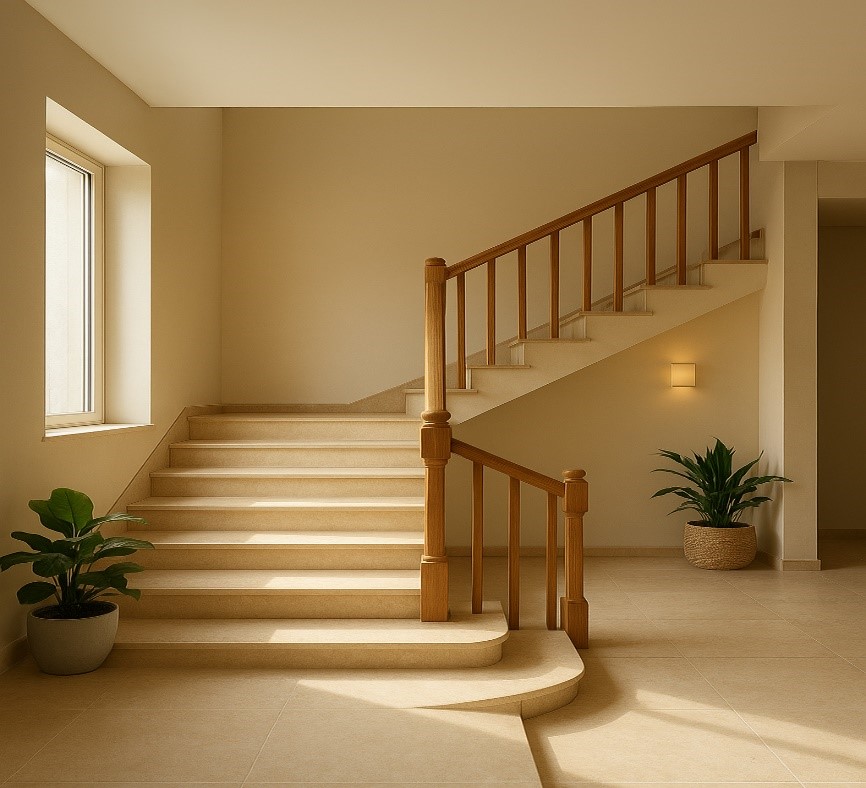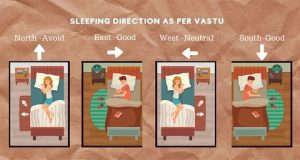When designing a home, every structural element contributes to the energy flow and harmony of the space. One often-overlooked element is the staircase, which, according to Vastu Shastra, holds significant importance in channeling positive energy. The direction, shape, placement, and even the material of your staircase can directly influence prosperity, health, and relationships in the household.
This in-depth 2025 guide will take you through everything you need to know about the staircase as per Vastu—from ideal directions for different house facings to remedies for existing Vastu doshas. Whether you’re building a new home or redesigning one, understanding the staircase direction as per Vastu will ensure that your home remains in balance with cosmic energies.
Why is Staircase Vastu Important in 2025?

In Vastu Shastra, the staircase isn’t merely a connector between floors—it represents movement and progress. An improperly placed staircase can cause financial instability, health issues, and interpersonal conflicts, while a staircase built according to Vastu enhances growth and prosperity.
In 2025, as architectural trends lean towards compact, vertical living spaces, following Vastu for staircase inside house becomes even more crucial. The principles remain timeless, but their relevance in modern layouts has only grown.
Which Direction is Best for Staircase as per Vastu?

The staircase direction as per Vastu is central to maintaining energy equilibrium. The southwest, south, and west are considered the most auspicious zones for constructing a staircase. These directions represent stability and grounding, making them perfect for heavy structures like stairs.
- Southwest Direction
This is the most recommended direction for staircases. It symbolizes support and strength, helping in maintaining stability in family finances and relationships.
- South Direction
If the southwest isn’t possible, the south direction is the next best alternative. However, ensure the staircase starts from the north or east and ascends towards the south or west.
- West Direction
A staircase in the west direction is favorable as it enhances career progress and brings long-term stability. However, it should never start from the south or southeast.
Avoid constructing staircases in the northeast (Ishanya) zone, as this corner represents divine energy and should remain light and open.
What is the Ideal Staircase Location as per Vastu?
When determining the staircase location as per Vastu, consider both internal and external staircases.
- Internal Staircase: Should ideally be placed in the southwest, south, or west zones inside the home.
- External Staircase: Best suited for the south, southwest, or west sides of the building façade. Avoid the northeast, as it can disturb the home’s positive vibrations.
For multi-storeyed homes, the staircase should not touch the northeast wall or cut across the center of the house. It should be designed in a clockwise ascending manner for positive energy flow.
Is Clockwise Movement Important in Vastu Staircase Direction?
Yes, Vastu staircase direction clockwise is considered highly auspicious. The staircase should rise from east to west or north to south in a clockwise manner.
The clockwise ascent symbolizes progress, expansion, and upward growth—key elements that bring success and prosperity. An anti-clockwise staircase, on the other hand, is believed to create mental tension and delays in achievements.
What is the Best Staircase Vastu for East Facing House?

For an east facing house, the staircase should ideally be located in the south or southwest part of the property.
Avoid placing the staircase in the northeast, as it can obstruct sunlight and create imbalance. The steps should ascend from north to south or east to west, maintaining a clockwise flow.
If an external staircase is required, ensure it is located in the southeast or south direction for better energy distribution.
What About Staircase Vastu for North Facing House?

The staircase vastu for north facing house follows slightly different principles. The staircase should be positioned in the west, south, or southwest zones of the plot.
A staircase in the northwest or northeast is not recommended as it may lead to career stagnation and financial hurdles. Ascending from north to south or east to west is ideal.
For such homes, avoid using a heavy staircase structure in the front portion of the plot—it may block prosperity from entering.
What is the Ideal Staircase Vastu for West Facing House?

The staircase vastu for west facing house allows for flexibility but requires careful direction alignment. The staircase should be in the south or southwest, ascending from east to west.
A staircase in the northwest can be considered only if space limitations exist, but ensure remedial measures are implemented to balance energies.
This direction strengthens professional growth and provides stability in decision-making.
What Should Be the External Staircase Direction as per Vastu?

For external staircases, the external staircase direction as per Vastu should follow the same directional logic as internal ones—south, southwest, or west are the best zones.
The staircase should always rise clockwise and end towards the west or south. Avoid placing external stairs in the northeast, as they obstruct spiritual and positive energies entering the home.
Can There Be a Pooja Room Under Staircase as per Vastu?

A pooja room under staircase vastu is strictly discouraged. The space under a staircase is considered heavy and used for downward movement, making it inauspicious for spiritual practices.
If you already have a pooja space beneath, use a remedy such as a raised platform or wooden partition to reduce negative impact and maintain sanctity.
What are the Remedies for North East Staircase Vastu Dosha?
A north east staircase vastu remedy becomes necessary if a staircase already exists in the northeast direction. Here are a few effective remedies:
- Place a Vastu pyramid under the staircase to neutralize energy imbalance.
- Paint the walls in light colors like white or cream to minimize heaviness.
- Keep the staircase well-lit to prevent stagnation of energy.
- Avoid storing clutter or heavy items beneath it.
These remedies won’t completely remove the dosha but can mitigate its negative influence significantly.
What Materials and Shapes are Recommended for Staircase According to Vastu?
When designing a staircase according to vastu, both material and shape matter.
- Materials: Prefer stone, marble, or concrete for durability and stability. Wooden staircases are acceptable indoors but should not dominate the main structure.

- Shapes: Rectangular or square stairs are best. Avoid spiral staircases as they cause energy distortion and can lead to confusion and instability.

The staircase should never have broken or uneven steps, as it signifies financial instability.
What Should You Avoid in Staircase Construction?
Avoid these common mistakes to ensure your staircase remains Vastu-compliant:
- Do not construct staircases in the northeast.
- Avoid placing toilets, kitchens, or pooja rooms beneath or beside staircases.
- Do not have hollow or open stairs—energy should flow uniformly.
- Avoid red or black colors on staircases; use light tones for positivity.
What Should be the Number of Steps in a Staircase as per Vastu?
According to Vastu for staircase, the number of steps should always be odd—such as 9, 11, 15, or 21.
This rule ensures that a person always lands on the right foot when beginning or completing the climb, symbolizing auspiciousness and positivity.
Should Staircases Have Doors?
Vastu suggests that the staircase should have doors at both the beginning and end if possible. This restricts unnecessary energy movement between floors and enhances privacy.
If adding doors is not feasible, placing decorative partitions or plants can achieve a similar balance.
South-East Staircase Vastu: Is It Good or Bad?
The south-east staircase vastu is generally considered unfavorable, as this direction represents the fire element (Agni).
A staircase here can intensify aggression and cause health-related problems. If unavoidable, use light beige or cream colors and place a small Vastu pyramid or copper strip at the base to neutralize its effects.
Lighting and Aesthetics in Staircase Vastu

Proper lighting is crucial. A well-lit staircase promotes healthy energy flow, while dark corners attract stagnation. Natural light is best, but if unavailable, use warm white lights.
Decor elements like indoor plants, mirrors, or artwork can be added, but avoid hanging mirrors directly opposite the stairs.
Conclusion
A well-planned staircase not only elevates your home’s design but also its energy. Following Vastu for staircase inside house ensures harmony, success, and stability for your family.
By respecting the staircase direction as per Vastu and correcting flaws through simple remedies, you can transform your home into a reservoir of positive energy in 2025.
At Housiey, we help homebuyers explore properties designed with Vastu-aligned principles, ensuring both comfort and cosmic harmony.
Ready to learn more about energy alignment? Don’t miss our next blog on “Best Direction to Sleep as per Vastu” for complete peace and prosperity.
FAQs
When designing a home, every structural element contributes to the energy flow and harmony of the space. One often-overlooked element is the staircase, which, according to Vastu Shastra, holds significant importance in channeling positive energy. The direction, shape, placement, and even the material of your staircase can directly influence prosperity, health, and relationships in the household.
This in-depth 2025 guide will take you through everything you need to know about the staircase as per Vastu—from ideal directions for different house facings to remedies for existing Vastu doshas. Whether you’re building a new home or redesigning one, understanding the staircase direction as per Vastu will ensure that your home remains in balance with cosmic energies.
Why is Staircase Vastu Important in 2025?

In Vastu Shastra, the staircase isn’t merely a connector between floors—it represents movement and progress. An improperly placed staircase can cause financial instability, health issues, and interpersonal conflicts, while a staircase built according to Vastu enhances growth and prosperity.
In 2025, as architectural trends lean towards compact, vertical living spaces, following Vastu for staircase inside house becomes even more crucial. The principles remain timeless, but their relevance in modern layouts has only grown.
Which Direction is Best for Staircase as per Vastu?

The staircase direction as per Vastu is central to maintaining energy equilibrium. The southwest, south, and west are considered the most auspicious zones for constructing a staircase. These directions represent stability and grounding, making them perfect for heavy structures like stairs.
- Southwest Direction
This is the most recommended direction for staircases. It symbolizes support and strength, helping in maintaining stability in family finances and relationships.
- South Direction
If the southwest isn’t possible, the south direction is the next best alternative. However, ensure the staircase starts from the north or east and ascends towards the south or west.
- West Direction
A staircase in the west direction is favorable as it enhances career progress and brings long-term stability. However, it should never start from the south or southeast.
Avoid constructing staircases in the northeast (Ishanya) zone, as this corner represents divine energy and should remain light and open.
What is the Ideal Staircase Location as per Vastu?
When determining the staircase location as per Vastu, consider both internal and external staircases.
- Internal Staircase: Should ideally be placed in the southwest, south, or west zones inside the home.
- External Staircase: Best suited for the south, southwest, or west sides of the building façade. Avoid the northeast, as it can disturb the home’s positive vibrations.
For multi-storeyed homes, the staircase should not touch the northeast wall or cut across the center of the house. It should be designed in a clockwise ascending manner for positive energy flow.
Is Clockwise Movement Important in Vastu Staircase Direction?
Yes, Vastu staircase direction clockwise is considered highly auspicious. The staircase should rise from east to west or north to south in a clockwise manner.
The clockwise ascent symbolizes progress, expansion, and upward growth—key elements that bring success and prosperity. An anti-clockwise staircase, on the other hand, is believed to create mental tension and delays in achievements.
What is the Best Staircase Vastu for East Facing House?

For an east facing house, the staircase should ideally be located in the south or southwest part of the property.
Avoid placing the staircase in the northeast, as it can obstruct sunlight and create imbalance. The steps should ascend from north to south or east to west, maintaining a clockwise flow.
If an external staircase is required, ensure it is located in the southeast or south direction for better energy distribution.
What About Staircase Vastu for North Facing House?

The staircase vastu for north facing house follows slightly different principles. The staircase should be positioned in the west, south, or southwest zones of the plot.
A staircase in the northwest or northeast is not recommended as it may lead to career stagnation and financial hurdles. Ascending from north to south or east to west is ideal.
For such homes, avoid using a heavy staircase structure in the front portion of the plot—it may block prosperity from entering.
What is the Ideal Staircase Vastu for West Facing House?

The staircase vastu for west facing house allows for flexibility but requires careful direction alignment. The staircase should be in the south or southwest, ascending from east to west.
A staircase in the northwest can be considered only if space limitations exist, but ensure remedial measures are implemented to balance energies.
This direction strengthens professional growth and provides stability in decision-making.
What Should Be the External Staircase Direction as per Vastu?

For external staircases, the external staircase direction as per Vastu should follow the same directional logic as internal ones—south, southwest, or west are the best zones.
The staircase should always rise clockwise and end towards the west or south. Avoid placing external stairs in the northeast, as they obstruct spiritual and positive energies entering the home.
Can There Be a Pooja Room Under Staircase as per Vastu?

A pooja room under staircase vastu is strictly discouraged. The space under a staircase is considered heavy and used for downward movement, making it inauspicious for spiritual practices.
If you already have a pooja space beneath, use a remedy such as a raised platform or wooden partition to reduce negative impact and maintain sanctity.
What are the Remedies for North East Staircase Vastu Dosha?
A north east staircase vastu remedy becomes necessary if a staircase already exists in the northeast direction. Here are a few effective remedies:
- Place a Vastu pyramid under the staircase to neutralize energy imbalance.
- Paint the walls in light colors like white or cream to minimize heaviness.
- Keep the staircase well-lit to prevent stagnation of energy.
- Avoid storing clutter or heavy items beneath it.
These remedies won’t completely remove the dosha but can mitigate its negative influence significantly.
What Materials and Shapes are Recommended for Staircase According to Vastu?
When designing a staircase according to vastu, both material and shape matter.
- Materials: Prefer stone, marble, or concrete for durability and stability. Wooden staircases are acceptable indoors but should not dominate the main structure.

- Shapes: Rectangular or square stairs are best. Avoid spiral staircases as they cause energy distortion and can lead to confusion and instability.

The staircase should never have broken or uneven steps, as it signifies financial instability.
What Should You Avoid in Staircase Construction?
Avoid these common mistakes to ensure your staircase remains Vastu-compliant:
- Do not construct staircases in the northeast.
- Avoid placing toilets, kitchens, or pooja rooms beneath or beside staircases.
- Do not have hollow or open stairs—energy should flow uniformly.
- Avoid red or black colors on staircases; use light tones for positivity.
What Should be the Number of Steps in a Staircase as per Vastu?
According to Vastu for staircase, the number of steps should always be odd—such as 9, 11, 15, or 21.
This rule ensures that a person always lands on the right foot when beginning or completing the climb, symbolizing auspiciousness and positivity.
Should Staircases Have Doors?
Vastu suggests that the staircase should have doors at both the beginning and end if possible. This restricts unnecessary energy movement between floors and enhances privacy.
If adding doors is not feasible, placing decorative partitions or plants can achieve a similar balance.
South-East Staircase Vastu: Is It Good or Bad?
The south-east staircase vastu is generally considered unfavorable, as this direction represents the fire element (Agni).
A staircase here can intensify aggression and cause health-related problems. If unavoidable, use light beige or cream colors and place a small Vastu pyramid or copper strip at the base to neutralize its effects.
Lighting and Aesthetics in Staircase Vastu

Proper lighting is crucial. A well-lit staircase promotes healthy energy flow, while dark corners attract stagnation. Natural light is best, but if unavailable, use warm white lights.
Decor elements like indoor plants, mirrors, or artwork can be added, but avoid hanging mirrors directly opposite the stairs.
Conclusion
A well-planned staircase not only elevates your home’s design but also its energy. Following Vastu for staircase inside house ensures harmony, success, and stability for your family.
By respecting the staircase direction as per Vastu and correcting flaws through simple remedies, you can transform your home into a reservoir of positive energy in 2025.
At Housiey, we help homebuyers explore properties designed with Vastu-aligned principles, ensuring both comfort and cosmic harmony.
Ready to learn more about energy alignment? Don’t miss our next blog on “Best Direction to Sleep as per Vastu” for complete peace and prosperity.
FAQs

















